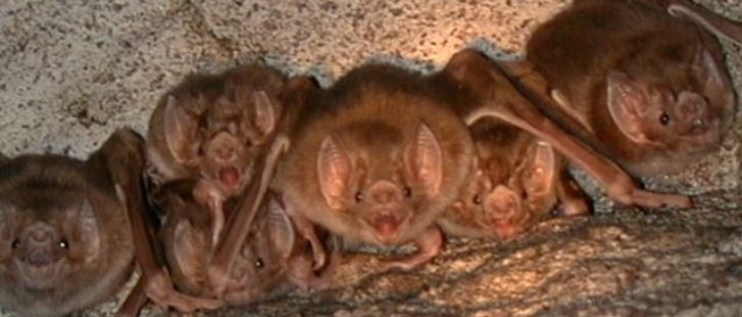
Nutrition
The diet of the common vampire bat is really quite simple. As most would assume, the common vampire bat, Desmodus rotundus, consumes the blood of other organisms.
 Whether or not a vampire
bat will be successful in dining on a fine mammal of its choice all
begins with a stealthy approach. The animals that vampire bats look
to prey on are so much larger that the wrong approach
could potentially leave the vampire to become the prey instead
of the predator. Vampire bats have the ability to walk, hop, and run
on their adapted thumbs and hind legs making it more simple for them
to sneak up
on their dinner (Riskin & Hermanson 2005). Once the bat is close to the animal it uses its
adapted nose leaf (to
learn more see adaptations) to detect
where the blood is flowing closest to the skin and where the blood
is the warmest (Gracheva et al. 2011). Once this ideal spot has been found the vampire bat
uses its front two incisors (teeth) to make a small incision in its preys
skin. Once the incision is made the bat uses its tongue to lap up the
oozing blood. The bat feeds for an average of twenty minutes per feeding
(Belwood & Morton 1991).
As the bat is lapping up the blood with its tongue the bat secretes
an anticoagulant into the incision to allow the wound
to bleed thoroughly without clotting. In one feeding a vampire bat can consume
up to half of its body weight. This may sound like a lot but a bat
only weighs an average of 1.6 ounces (a-z-animals.com). The amount of
blood a vampire bat takes from its prey usually equals to be about a
tablespoon which is not enough to harm the animal (Breidenstein 1982).
Diseases the bats may carry and the blood loss from the incision is what can cause harm and possible
death in a vampire bat’s prey. To learn more about the vampire bats
relationship with other animals click
here.
Whether or not a vampire
bat will be successful in dining on a fine mammal of its choice all
begins with a stealthy approach. The animals that vampire bats look
to prey on are so much larger that the wrong approach
could potentially leave the vampire to become the prey instead
of the predator. Vampire bats have the ability to walk, hop, and run
on their adapted thumbs and hind legs making it more simple for them
to sneak up
on their dinner (Riskin & Hermanson 2005). Once the bat is close to the animal it uses its
adapted nose leaf (to
learn more see adaptations) to detect
where the blood is flowing closest to the skin and where the blood
is the warmest (Gracheva et al. 2011). Once this ideal spot has been found the vampire bat
uses its front two incisors (teeth) to make a small incision in its preys
skin. Once the incision is made the bat uses its tongue to lap up the
oozing blood. The bat feeds for an average of twenty minutes per feeding
(Belwood & Morton 1991).
As the bat is lapping up the blood with its tongue the bat secretes
an anticoagulant into the incision to allow the wound
to bleed thoroughly without clotting. In one feeding a vampire bat can consume
up to half of its body weight. This may sound like a lot but a bat
only weighs an average of 1.6 ounces (a-z-animals.com). The amount of
blood a vampire bat takes from its prey usually equals to be about a
tablespoon which is not enough to harm the animal (Breidenstein 1982).
Diseases the bats may carry and the blood loss from the incision is what can cause harm and possible
death in a vampire bat’s prey. To learn more about the vampire bats
relationship with other animals click
here.
